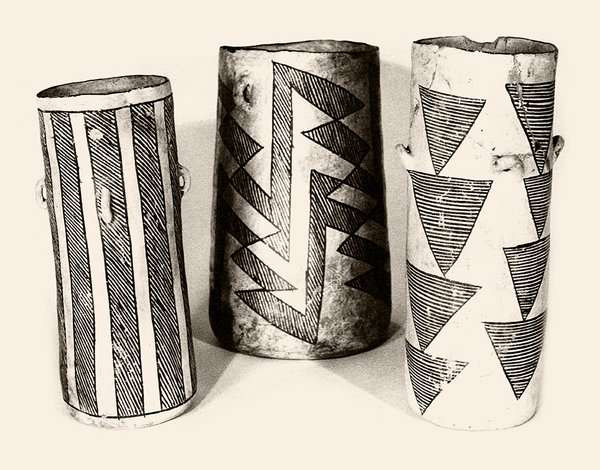 |
| Aerial view of Pueblo Bonito |
 |
| Aerial view of Pueblo Bonito Note the remains of "Threatening Rock" in upper right |
purpose. Despite a large piece of the canyon wall, later named “Threatening Rock”, that had broken loose and would undoubtedly fall someday, they stubbornly stuck to their plan. Threatening Rock did come down and knocked out a good portion of the back wall January 1941 (note the rock pile in the lower left of the picture above). Something about that spot made it critical that it be placed there.
What is the structure? It is Pueblo Bonito at Chaco Culture National Historical Park in northwestern New Mexico.
Another interesting anomaly is the design of Pueblo Bonito. The floor plan is in the shape of a “D” or, as our tour guide pointed out, a “half moon”. Looking at the aerial view are you seeing another striking similarity to the moon? The craters? Well, before we get too carried away, the round kivas would have been covered! Most Great Houses were square or rectangular or, if they had a curved wall, it was in front of the courtyard. But almost always, the back wall was straight. (Of course, other would be houses that were unplanned or built on covered ledges like at Mesa Verde). At Pueblo Bonito, the entire back wall is curved and the wall in front of the courtyard is straight.
 |
| Tour of Casa Rincanada Canyon wall between Pueblo Bonito and Chetro Ketl is in the background |
Although Pueblo Bonito probably contained over 800 rooms in its heyday, research suggests that very few people lived in the Great Houses permanently. For instance, there were very few burials found in the canyon. This would suggest that the Great Houses in Chaco canyon were more like resorts than villages. Goods from all over the southwest, Central America, and the east support the theory that Chaco Canyon was a central trading hub. It is more likely, that people came to the canyon to trade their goods and while there experience the lavish ceremonial events staged in the Great Kivas, large dance fields, and great plazas.
Pueblo Bonito would have been a most impressive place to visit back then. With the best architecture and construction, oversized rooms, grand courtyards, huge Kivas, and massive storage facilities, it would have been a spectacle. It was like no other place in the southwest. Even in a canyon where Great Houses dotted the valley and canyon rims, it was (and is) unique.
 Imagine approaching this enormous, five-story “hotel” covering three acres with an enormous courtyard in front where dancers in brightly colored costumes were dancing to the thundering beat of massive foot drums, melodious flutes, rattles and chanting singers. A massive round Kiva sitting in the center of the courtyard held impressive ceremonial rituals. I imagine that it might have been like going to New York City on business and taking in Broadway plays and shopping.
Imagine approaching this enormous, five-story “hotel” covering three acres with an enormous courtyard in front where dancers in brightly colored costumes were dancing to the thundering beat of massive foot drums, melodious flutes, rattles and chanting singers. A massive round Kiva sitting in the center of the courtyard held impressive ceremonial rituals. I imagine that it might have been like going to New York City on business and taking in Broadway plays and shopping.A SIDE NOTE:
These cylinder jars from Pueblo Bonito contained chocolate! It was in liquid form and imported from Central America for elite guests. In some Maya ceremonies a cacao beverage was frothed by pouring the liquid from one vessel to another. The Maya were known to ground cacao beans, mix them with spices, chilies, and water, and frothed the drink for consumption either hot or cold. In addition to this exotic drink, trade with Central America included rare Quetzal feathers and parrots.

No comments:
Post a Comment